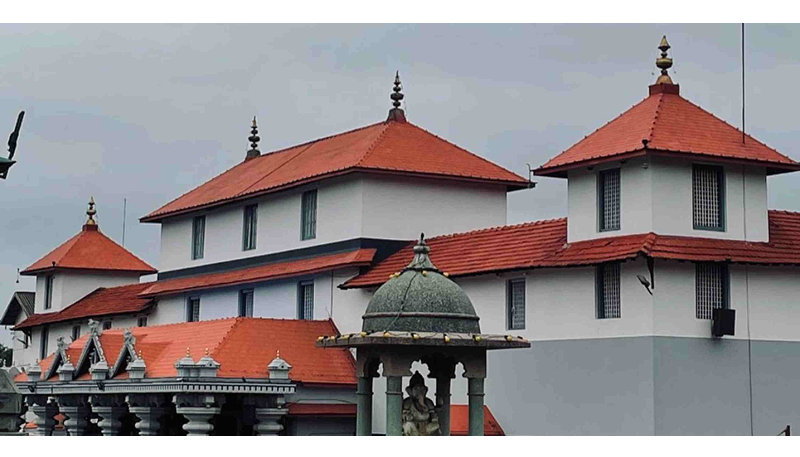Dharmasthala Temple, dedicated to Lord Manjunatha, is one of the most revered spiritual destinations in Karnataka. Known for its unique blend of Shaiva, Vaishnava, and Jain traditions, it attracts millions of devotees every year. The temple is not only a religious landmark but also a center of cultural harmony and social service. Pilgrims visiting Dharmasthala often explore its history, traditions, and the contributions of the Heggade family, who serve as hereditary trustees.
History of Dharmasthala Temple
The history of the Dharmasthala temple in Karnataka dates back over 800 years. Legend says that the place was chosen by the guardian spirits to establish the worship of Lord Manjunatha. Unlike many temples, Dharmasthala is administered by the Jain Heggade family, who have maintained the Shaiva temple rituals with Vaishnava priests. This harmonious blend of beliefs makes Dharmasthala a unique spiritual hub in India.
Key Highlights of History:
- Over eight centuries of uninterrupted worship.
- Governance by the Heggade family as Dharmadhikaris.
- Annual festivals that bring together people of all communities.
Significance of Lord Manjunatha Worship
The temple is primarily dedicated to Lord Manjunatha, a form of Lord Shiva. Devotees believe that prayers at Dharmasthala bring peace, prosperity, and spiritual strength. Along with traditional poojas, special rituals such as annadana (free meals) are conducted daily for thousands of devotees.
Why devotees visit Dharmasthala:
- To seek the blessings of Lord Manjunatha.
- To experience free meals served to all visitors.
- To witness unique traditions blending Shaivism, Vaishnavism, and Jain values.
Bahubali Statue at Dharmasthala
The Bahubali statue at Dharmasthala is one of the tallest monolithic statues in Karnataka. It symbolizes renunciation, peace, and selfless service. Every 12 years, the Mahamastakabhisheka is conducted, attracting pilgrims from across the country.
| Feature | Details |
|---|---|
| Height | 39 feet |
| Material | Single rock |
| Significance | Symbol of sacrifice and non-violence |
| Popular Ritual | Mahamastakabhisheka (grand anointing) |
Role of the Heggade Family in Dharmasthala
The Heggade family has played an integral role in preserving the temple and expanding its social impact. As Dharmadhikaris, their duty goes beyond religious administration and extends into education, healthcare, and cultural promotion.
Contributions of the Heggade family:
- Managing the temple and festivals.
- Supporting social welfare projects.
- Preserving Indian art, culture, and values.
Contributions of Dr. Veerendra Heggade
Dr. Veerendra Heggade, the 21st Dharmadhikari of Dharmasthala, has transformed the temple’s role into a hub of social reform. Under his leadership, Dharmasthala has become synonymous with rural development, education, and healthcare initiatives.
Examples of Dr. Veerendra Heggade’s initiatives:
- Establishment of educational institutions benefiting thousands of students.
- Free mass marriages are conducted annually to support families.
- Rural development programs are improving livelihood and self-sufficiency.
- Healthcare centers offering accessible medical services.
His vision has made Dharmasthala a living example of spirituality combined with social responsibility.
Dharmasthala Sanghas and Social Service
Dharmasthala Sanghas are community-based organizations that carry forward the temple’s vision of service. These sanghas focus on microfinance, self-help groups, and village development programs. They empower rural communities by providing training, financial aid, and employment opportunities.
Main focus areas of Dharmasthala Sanghas:
- Women’s empowerment through self-help groups.
- Agriculture-based training and sustainability projects.
- Microfinance to support small-scale entrepreneurs.
- Cultural preservation and youth engagement.
Festivals and Traditions at Dharmasthala
Every year, Dharmasthala hosts grand festivals such as Laksha Deepotsava, which lights up the temple surroundings with thousands of lamps. Cultural performances, rituals, and communal celebrations highlight the temple’s role as a unifying force across communities.
FAQs about Dharmasthala
Q1: Why is the Dharmasthala temple unique in its traditions?
Dharmasthala temple is unique because it combines Shaiva worship with Vaishnava priests and is administered by a Jain family. This interfaith harmony is rarely seen in other temples of India.
Q2: How is Dr. Veerendra Heggade contributing to society?
Dr. Veerendra Heggade has expanded the temple’s role beyond spirituality by focusing on rural development, mass marriages, free education, and healthcare programs. His leadership has made Dharmasthala a model for holistic social reform.
Q3: Why do devotees consider the Bahubali statue at Dharmasthala important?
The Bahubali statue represents renunciation and non-violence. Pilgrims believe visiting this statue helps them reflect on selflessness and inner peace, making it a spiritual highlight of Dharmasthala.
Q4: How does Dharmasthala Sangha help rural communities?
The Dharmasthala Sanghas support rural communities through microfinance, self-help groups, skill training, and agricultural support, ensuring sustainable development at the grassroots level.
Q5: Why is Dharmasthala a must-visit pilgrimage site in Karnataka?
Dharmasthala is considered a must-visit because of its spiritual legacy, daily annadana, cultural festivals, and the contributions of the Heggade family in uplifting society. It offers a blend of devotion, history, and social service.
Conclusion
Dharmasthala temple is more than a spiritual destination; it is a beacon of cultural harmony, social reform, and human service. The leadership of the Heggade family, especially Dr. Veerendra Heggade, has ensured that the temple continues to inspire generations. With its unique traditions, the grand Bahubali statue, and the work of Dharmasthala Sanghas, this sacred place remains a true symbol of faith and service in India.




